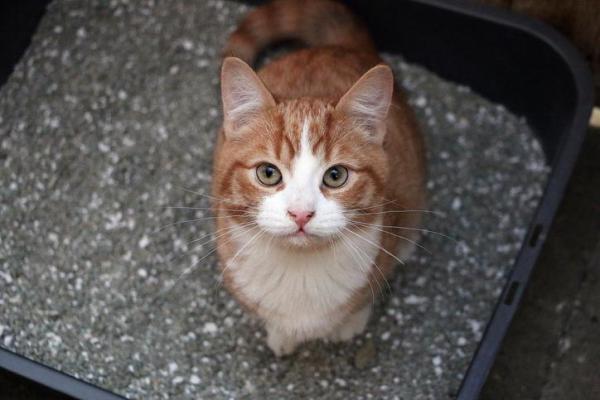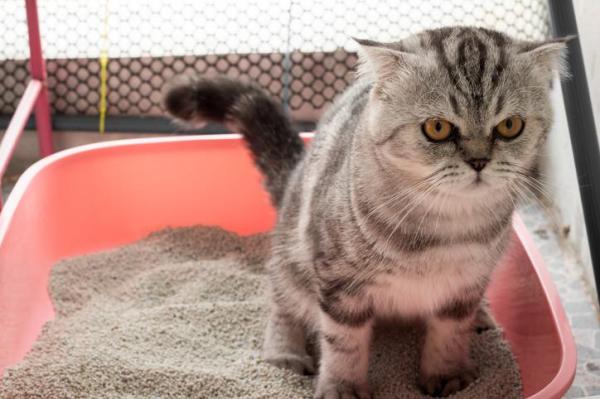
In may be unpleasant to check our cat's litter tray, but finding crystals in their urine is just one reason why it is important. Crystals which are passed on their own may not cause a severe problem, but the likelihood is that they indicate the formation of struvite crystals, commonly known as bladder stones (also known as uroliths). Secondary effects of these crystal stones include obstruction, something which constitutes a veterinary emergency.
If your cat has crystals in their urine, you need to understand the causes behind them. At AnimalWised we look at these causes, as well as factors which predispose your cat to developing them and what can be done to prevent their formation.
Causes of crystals in cat urine
The first thing we should note is that crystals in a cat's urine are formed by substances found naturally in a cat's body. The problem arises when these substances group together to form different types of crystals (see below). Different circumstances can lead to such an accumulation. Problems for crystals in urine are more common with male cats as they have a narrower urethra. The age of onset is usually relatively early at between 2 and 5 years.
Before crystals develop, the cat may have something known as crystalluria. This is when the cat's urine becomes cloudy due to the present of mineral deposits. It is commonly associated with cystitis and urinary tract infections in cats[1].
Other than age, risk factors for cats developing crystals in their urine include:
- Obesity: a poor diet and bad metabolism stemming from obesity in cats can influence the accumulation of crystal-forming substances.
- Dehydration: decreases the volume or urine. Another reason cats need constant access to fresh clean water.
- Infections disease: other than urinary tract infections, crystals can be a secondary symptom of certain pathologies.
- Stress: it is more common in cats which are particularly sensitive to changes in their routine.
When the cat's urine is concentrated due to dehydration, the risk of crystals forming is increased. This is why it is important to note how often your cat urinates throughout the day. We also should note how much water they drink throughout the day. If it is not often enough, it can be a sign of a problem.
If you suspect that the cause of the crystals in your cat's urine is stress, take a look at our article on causes of stress in cats.
Symptoms of crystals in cat urine
Symptoms of crystals in the urine in cats include:
- Pain when urinating
- Sluggishness
- Hematuria (blood in the cat's urine)
- Urinating outside the litter box
There are various reasons for blood in a cat's urine, bladder stones and other crystals being only one of them. You will see the urine has changed color to a cloudy gold or reddish tone.
If we detect any of these symptoms we must go to the vet quickly as deferring it can lead to serious health problems. Crystals in the cat's urine are one of the causes of FLUTD (feline lower urinary tract disease), a wide range of disease which affect their urinary tract. In severe cases where large stones form, the cat may exhibit vomiting, lethargy, pain or a distended abdomen. A complete blockage may be fatal.
FLUTD in cats has various other symptoms. In male cats, it is one of the reasons why they push their penis out to lick it. Female cats may also excessively lick their private area which indicates to us there us a problem.

Types of crystals in cat urine
Depending on the minerals present and the characteristics of the urine, different types of crystals can form uroliths in of cats. The most frequent types or urine crystals in cats include:
- Struvite: composed of magnesium and ammonium phosphate. This is a problem which can lead to serious problems such as kidney stones. Its incidence is currently decreasing due to awareness and changes to diet via commercial food products. Diet can do this by modifying the pH level of the urine and lowering magnesium levels.
- Calcium oxalate: contrary to struvite, calcium oxalate is becoming more frequent. While dietary changes cause less magnesium intake, this can improve circumstances to result in calcium oxalate crystals.
- Ammonium urate: the primary causes of ammonium urate crystals is not well-known. The uroliths may form in combination with other minerals.
- Uric acid: uric acid uroliths have a hexagonal shape and can be bright yellow or green.
- Calcium phosphate: occasionally these can develop together with struvite crystals.
- Cystine: cystine crystals are very uncommon in cats.
Regardless of the type, the crystals can be located anywhere in the urinary tract. The symptoms are often related.
How to eliminate crystals and uroliths in cats
The treatment of crystals in cat urine will depend on the type of crystal present. This is why it is important to achieve a proper diagnosis from a veterinarian. From a urine sample, the vet can identify the crystals by viewing them under a microscope. It is not always easy to appropriate a urine sample, which is why the veterinarian often has to extract it directly from the bladder of the cat. Stones can be seen with an x-ray, ultrasound or both.
Drugs can be used to remove some crystals. In addition, an important part of the treatment is diet and hydration, as we will see in more detail in the next section. With a specific diet, the struvite crystals can be dissolved. On the other hand, those of calcium oxalate are not going to be treated by dietary modification. If necessary, they will have to be removed with an operation. Cases of total obstruction are also resolved by surgical intervention.

Diet for cats with urine crystals and bladder stones
On the market we can find different comercial feeds formulated specifically to dissolve and prevent the formation of crystals in cat urine. They are low in protein, balanced in minerals and high in sodium. They modify the pH level to prevent an excess of mineral accumulation, as well as increase water intake.
In the case of struvite crystals, the aim is to reduce ammonium phosphate, magnesium and pH levels. For cystine or urate amino acid accumulation, proteins are reduced. The cat must consume these foods for a few weeks to eliminate the crystals. Not only is diet essential, but hydration also plays an essential role. Cats can be inclined to drink insufficient amounts of water.
Feeding with only dry food can affect hydration. This is a problem since good hydration is essential for proper urine elimination. With the presence of crystals, it is necessary to increase the volume of urine to decrease its concentration. This is why we should provide cats prone to developing uroliths with a mixed diet of both dry and wet food.
In addition, the cat must be encouraged to drink more water in general. This can be achieved by providing more water dishes or even using a fountain. The latter is ideal since cats enjoy drinking from a moving stream of water. Dividing their daily amount of food into smaller more frequent portions can also encourage drinking. Finally, quality is vital. Poor quality cat food can affect their general well-being, encouraging the development of urine crystals.
For some extra tips to help your cat drink more water, check out our video below:

This article is purely informative. AnimalWised does not have the authority to prescribe any veterinary treatment or create a diagnosis. We invite you to take your pet to the veterinarian if they are suffering from any condition or pain.
If you want to read similar articles to My Cat Has Crystals in Their Urine, we recommend you visit our Other health problems category.
1. Bell, E. T., & Lulich, J. P. (2015). Marked struvite crystalluria and its association with lower urinary tract signs in a cat with feline idiopathic cystitis. Australian Veterinary Journal, 93(9), 332-335.
https://pubmed.ncbi.nlm.nih.gov/26313212/
- Baciero, G. (n.d.). The key to treating feline urolithiasis is urinary dilution. Veterinary Axon, 42, 42-45.